[[bpstrwcotob]]

Designing Science Spaces That Balance Performance and Sustainability
Nucleus, a science facility shared by Scripps and Pitzer Colleges, demonstrates how thoughtful, human-centered design and high-performance systems can create a sustainable, energy-efficient science facility that balances operational functionality with ambitious decarbonization goals

2026 Lab Design Conference Advances Sustainable Lab Design and Industry Innovation
The 2026 Lab Design Conference in Orlando, FL, May 11–14, provides lab professionals, architects, and planners with hands-on experience, expert insights, and actionable strategies—particularly in sustainable lab design, energy efficiency, and decarbonization—to optimize and future-proof laboratory environments

Enveda’s Biophilic Vision Earns Excellence in Small Project Design
Enveda Biosciences’ Boulder headquarters—winner of the 2025 Design Excellence Award for Small Project Design—transforms a former office building into a flexible, biophilic life sciences facility that embodies the company’s mission of “unlocking nature’s potential” through sustainable design, operational efficiency, and a deep connection between people, science, and the natural world

Eleven-Story Somerville Lab Building Earns LEED Platinum Certification
808 Windsor Street, a life science research building in Somerville, MA, achieved LEED Platinum through high-performance design, energy-efficient systems, water-saving features, and collaborative planning that prioritized sustainability, occupant well-being, and community engagement

Choosing the Right Vendors for Your Lab Build or Renovation
Successfully selecting vendors for a lab build or renovation requires careful coordination, strategic partnerships, and thoughtful evaluation to ensure long-term efficiency, safety, and innovation

Webinar Review: Building the Sustainable Automated Lab of the Future
The on-demand webinar, “How to Build a Sustainable Automated Lab,” explores how automation, robotics, and AI are reshaping research environments and offers practical guidance on designing flexible, energy-efficient laboratories

Building Better Labs with Mass Timber: Sustainability, Speed, and Wellness in Design
Mass timber is transforming laboratory design by offering a low-carbon, high-performance alternative to steel and concrete, enabling faster construction, precision-engineered research spaces, and human-centered environments that support wellness, collaboration, and sustainability

Balancing Timber, Steel, and Research Innovation: A Hybrid Approach to Lab Design
The University of Arkansas’ I³R facility combines advanced labs, collaborative spaces, and a hybrid mass timber–steel design to foster interdisciplinary research, address complex societal challenges, and connect the university with the local community and industry

Project Profile: Roy Blunt Hall Addition, Missouri State University
Missouri State University has completed an addition to Roy Blunt Hall, marking the first phase of a larger project designed to showcase science while providing flexible, sustainable facilities for future growth

Welch’s Lab Relocation Sets Stage for Growth
Welch’s has undertaken a major lab relocation to a modern, purpose-built facility in Waltham, MA—a move that reflects a strategic effort to foster collaboration, improve lab efficiency, and align its physical space with long-term research, operational, and sustainability goals
